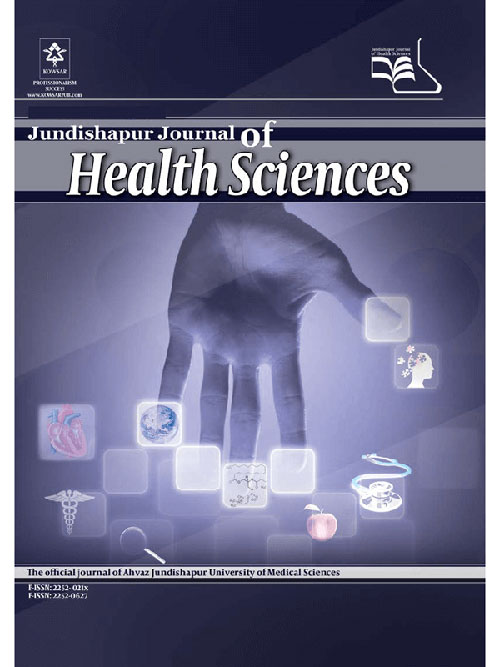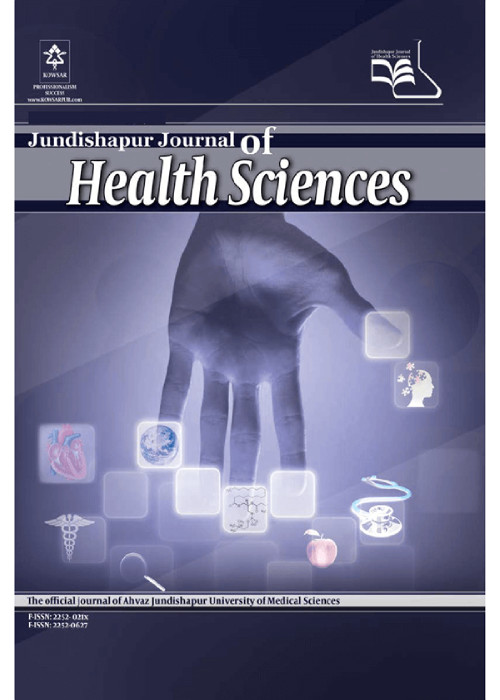فهرست مطالب

Jundishapur Journal of Health Sciences
Volume:14 Issue: 1, Jan 2022
- تاریخ انتشار: 1401/01/16
- تعداد عناوین: 7
-
-
Page 1Background
Depression and sexual dissatisfaction are among the most common psychological factors caused by infertility. Infertility is an essential topic in the Iranian culture, and many studies have already investigated it.
ObjectivesThis study aimed to compare the depression severity and sexual dissatisfaction between fertile and infertile women in Iran.
MethodsThis case-control study enrolled 180 infertile women and 540 fertile women in 2019. The participants were selected through multistage stratified and cluster sampling methods. For each infertile woman, three fertile women were randomly selected. The data collection instruments consisted of a demographic form, the Depression Inventory Scale (Second Edition), and the Linda Berg Sexual Satisfaction Questionnaire. The multivariate marginal model and SPSS version 21 were used for data analysis at a significance level of 0.05.
ResultsAfter adjustment for confounding variables, the marginal model showed that the odds of depression increased by approximately 21.305 times among cases compared to controls (OR = 21.305, 95% CI = 14.75 - 32.021, P < 0.001). This model also found that by moderating the effects of confounding variables, infertility increased the odds of low sexual satisfaction by approximately 15.560 times (OR = 15.560, 95% CI = 5.089 - 47.571, P < 0.001). The chi-square test showed a significant relationship between infertility treatment and depression severity in infertile women (P = 0.001).
ConclusionsThe overall depression severity and sexual dissatisfaction were higher in the infertile group than in the fertile one. Most cases of severe depression were observed in IVF clinics with higher depression levels. The study may help reveal infertility’s psychological and social aspects in Iran.
Keywords: Depression, Sexual Satisfaction, Infertility, Case-Control Study, Iran -
Page 2Background
The undesirable conditions resulting from addiction can be mitigated with timely diagnosis and effective interventions. Distress tolerance can be promoted in adolescents with a drug-dependent parent.
ObjectivesThe present study aimed to investigate the effectiveness of mindfulness-based stress reduction (MBSR) therapy and emotion regulation training (ERT) on the distress tolerance of adolescent girls with a drug-dependent parent in Ahvaz, Iran.
MethodsThis clinical trial was performed on the experimental and control groups as the pretest-posttest design with follow-up. The statistical population included all the adolescent girl students with a drug-dependent parent in Ahvaz. The sample consisted of 45 adolescents with a drug-dependent parent selected by cluster sampling. The participants were randomly divided into two experimental groups of MBSR (eight 60-min sessions) and ERT (eight 45-min sessions) and a control group (n = 15 per group). All three groups were followed up after 45 days. The research instrument was the Distress Tolerance Scale (DTS), and data were analyzed using the analysis of covariance.
ResultsMBSR and ERT enhanced distress tolerance in adolescent girls with a drug-dependent parent (P < 0.001). The effects of the two interventions were not significantly different, and this result persisted in the follow-up stage.
ConclusionsMBSR and ERT increased distress tolerance in adolescent girls with a drug-dependent parent. Therefore, these two interventions can be administered to enhance the mental health of adolescents.
Keywords: Addiction, Adolescents, Anxiety, Emotion Regulation, Mindfulness, Stress -
Page 3Background
Tuberculosis (TB) is one of the most important infectious diseases worldwide. Bacillus Calmette-Guerin (BCG) is a live attenuated vaccine, entered into the childhood immunization program by the World Health Organization (WHO) in 1974 to prevent TB. One of the relatively common complications of BCG vaccination is regional lymphadenitis.
ObjectivesThis study aimed to determine the lymphadenitis incidence in BCG-vaccinated children in southwest Iran.
MethodsIn a prospective descriptive study, infants born from March to June 2017 were evaluated for BCG vaccine complications at two, four, six, nine, and 12 months of age in Ahvaz, southwestern Iran.
ResultsThe study enrolled 1,506 infants (794 males and 712 females). Among the vaccinated infants, four (0.26%) had injection site reactions, and 106 (7.03%) presented lymphadenitis (66 males and 40 females). The lymphadenitis rate was significantly higher in males than in females (P = 0.024). The mean age at presentation was 4.28 ± 0.79 months. Suppurative lymphadenitis was seen in 53 (50%) cases and nonsuppurative lymphadenitis in 53 (50%) cases. About 80% of nonsuppurative lymphadenitis resolved entirely or partially after a one-year follow-up. Of 53 cases with suppurative lymphadenitis, 46 (43.4%) developed spontaneous drainage, and seven (6.6%) were drained by needle aspiration. No significant relationship was found between the BCG inoculation site and lymphadenitis rate. No other complications such as osteomyelitis or disseminated BCG infection were observed after one year of follow-up.
ConclusionsThe relatively high incidence of BCG lymphadenitis in this study may be due to the vaccine strain, young vaccinees, and improper vaccination techniques. In most cases, nonsuppurative lymphadenitis regressed spontaneously, and suppurative lymphadenitis was drained spontaneously or by needle aspiration.
Keywords: BCG Vaccination, Children, Lymphadenitis -
Page 4
According to the results obtained thus far, ozone/magnetic copper ferrite nanoparticles (CuFe2O4 MNPs)/potassium hydrogen monopersulfate (KMPS) is capable of totally degrading 20 mg/L diazinon (DZN) with 6 mg/L ozone, 0.6 g/L KMPS, and 0.1 g/L MNPs at pH = 7 in 20 min. The experiments showed that the concentrations of KMPS and MNPs were more effective than ozone on the system efficiency. Moreover, high concentrations of KMPS and MNPs were not very effective in DZN degradation. Furthermore, the degradation efficiencies of diazinon at pHs 3, 4, 5, 6, 7, 8, 9, and 10 were 94%, 95.35%, 97.45%, 98.15%, 99.2%, 99.3%, 99.3%, and 100%, respectively. The pH of the solution was effective on the system so that in the range of 7 - 10, the system had high efficiency. Even within the range of 3 - 6, the pH had not been so plummeted, resulting in a high percentage of DZN degradation. Besides, MNPs could be utilized in the system for up to five cycles without any loss of catalytic activity. The degradation efficiency of diazinon was 99.2% in the first use and 92.1% in the fifth use. Also, the process efficiency was assessed in four real environments showing that agricultural drainage and urban wastewater with the degradation percentages of 79.1% and 77.3%, respectively, were better treated than the urban and river water with the percentages of 93% and 88.4%, respectively. With the determination of active agents in the reaction using the scavenging agents, it was recognized that sulfate radicals, hydroxyl radicals, superoxide, and singlet oxygen contributed to DZN degradation. By the way, ozone was advantageous to both singlet oxygen and superoxide in the degradation of diazinon.
Keywords: Advanced Oxidation Processes, Magnetic Nanoparticles, Degradation, Diazinon -
Page 5Background
Incineration is a waste disposal technique employed to reduce the volume of waste, resulting in air pollution.
ObjectivesThis study aimed to determine the knowledge, attitude, and practice on health behaviors among Rasht villagers regarding air pollution from burning waste.
MethodsThe present descriptive cross-sectional study was conducted among 260 rural households in Rasht. Data were collected using a questionnaire by interviewing participants. The participants were randomly selected and entered the study. Data were analyzed by SPSS version 16 using the t-test, one-way ANOVA, and Pearson correlation at a 95% confidence interval. the content validity index (CVI) and content validity ratio (CVR) were used to assess the instrument’s validity. Cronbach’s alpha coefficient was calculated to evaluate the questionnaire reliability.
ResultsThe findings confirmed the optimal validity and reliability of the instrument used in the study. The participants’ age range was 19 to 78, with a mean age of 43.87 ± 12.66 years. The practice had a significant positive correlation with knowledge (r = 0.216). The correlation between practice and attitude was positive but not statistically significant. Education and information on burning wastes had a substantial relationship with knowledge. Participants received 80%, 29.3%, and 66.7% of the maximum achievable scores for knowledge, attitude, and practice components in the questionnaire, respectively.
ConclusionsThe villagers’ attitude in performing health behaviors regarding air pollution was not favorable, and there is a need to provide educational and behavioral interventions in this regard.
Keywords: Attitude, Incineration, Knowledge, Practice, Waste -
Page 6Context
The early detection of COVID-19 is of paramount importance for the disease treatment and control. As real-time reversetranscription polymerase chain reaction indicates a low sensitivity, the computed tomography of patients’ chest can play an effective role in the diagnosis of COVID-19, particularly for patients with false-negative RT-PCR tests. It is also effective in monitoring the clinical trends and assessing the severity of the disease.
ObjectivesAccordingly, this study aimed to review the different manifestations of the COVID-19 infections in high-resolution computed tomography images of patients’ chests and analyze the distribution of the disease in the lungs. The results can contribute to providing a comprehensive and concise reference on the appearance of various types of involvement and lung lesions and the extent of these lesions in the COVID-19 patients. Data Sources: We systematically searched four major indexing databases (namely PubMed, Science Direct, Google Scholar, and Cochrane Central) for articles published by May 2021 using the following keywords: High-Resolution Computed Tomography (HRCT), COVID-19, and Manifestations.
ResultsOverall, 29 studies addressing the role of HRCT in detecting and evaluating the manifestations of the COVID-19 infection in patients’ lungs as ground glass opacification (GGO), consolidation, irregular solid nodules, fibrous stripes, crazy paving pattern, air bronchogram sign, etc. were reviewed.
ConclusionsGGO was the most common finding, as reported in 96.6% of the reviewed articles, followed by consolidations (65.5%) and irregular solid nodules (55.2%). Most patients revealed the disease process as a bilateral distribution in the peripheral areas of the lung.
Keywords: COVID-19, Manifestations, High-Resolution Computed Tomography -
Page 7
The current study examines the effects of a hospital information system (HIS) on the performance of management units in Ahvaz public hospitals, Iran. The HIS supports hospital activities at practical, tactical, and strategic levels. In other words, this system establishes a connection between patient care and administrative information in all hospital activities. This descriptive-analytic research was an applied study with a correlational method. The hypotheses were tested by correlation model, structural equation modeling, one-sample t-test, one-way analysis of variance, and one-sample Kolmogorov-Smirnov test using the SPSS software version 20 and LISREL. The findings of this study indicated that an automated HIS can be a powerful tool helping managers with the process of hospital management and decision-making, leading to significantly improved hospital performance. Therefore, continuous training courses are beneficial in enhancing information quality and modern technology usage, which in turn improve the quality of services offered to patients and clients and make them less time-consuming. As a result, an effective step is taken in improving health services. The present study showed that the characteristics of HIS, including user-friendliness, speed, quality, being up-to-date, conformity with working conditions, and proficiency, have positive and significant impacts on the performance of management units.
Keywords: Hospitals Information System, Performance of Management Units, Ahvaz Public Hospitals


